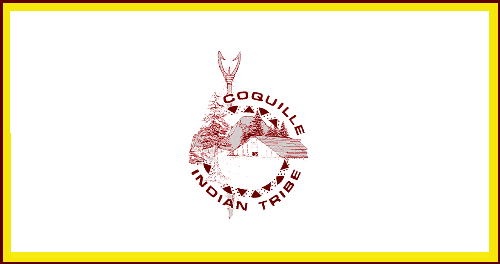| Library | Lane | Search Lane | Catalog |
| Contact Us | Web Site Accessibility |

| Don Macnaughtan | Lane Community
College Library Eugene, Oregon 97405 macnaughtand@lanecc.edu |

|
|
The flag of the Coquille Indian Tribe
Reprinted from Raven: A Journal of Vexillology Volumes 3/4 (1996-1997).

Click for detailed image of the tribal seal.
The flag of Oregon's Coquille Indian Tribe is a plain white banner fringed in gold, with the tribal seal in maroon or wine red. The flag is displayed at the Mill Casino and at the headquarters of the 650-strong tribe in Coos Bay, in southwest Oregon. (1)
The Coquille have lived along the bays and estuaries of southwest Oregon for more than 6,000 years. In the 19th century they were ravaged by malaria, smallpox, and an invasion of gold miners in the 1850s that reduced their population from 8,000 to a few hundred scattered survivors. Although declared extinct in 1954, the Coquille were granted federal recognition in 1989. Since then, they have re-emerged as a vital and thriving community and an economic asset to the Coos Bay region of Oregon, becoming a major employer in an area devastated by a decline in the timber industry.
The flag of this now-thriving nation dates from the early 1980s, according to the Coquille Tribal Library. The maroon seal, on a white background, celebrates the history and culture of the Coquille people. In the center is an Oregon Coast "plank house," the traditional style of housing in southwestern Oregon. Behind the house is UmnatL QwLai, "Grandmother Rock" in the Miluk Coos language, a sacred tribal site at the mouth of the Coquille River. While the rock itself was destroyed by the federal government in the 19th century, the site remains sacred and the rock is depicted on the seal. A conifer tree to the left of the rock and others behind the house recall the forest and the timber industry which have long been elements in Coquille life. Behind the seal, protruding from the top is a Coquille fishing spear. Fishing has been vital to the Coquille's existence for millennia.
Surrounding the seal are two distinct elements. The first is the text "COQUILLE INDIAN TRIBE". The second, a distinctive arrangement of large and small triangles, represents the tattoo markings which the people of the southwestern coast of Oregon used to measure the strings of dentalia - the local shell money of the ancient population.
Footnotes:
(1) Don Macnaughtan "Lost and found heritage: recovering American Indian tradition at the Coquille Tribal Library, Bandon, Oregon" New Zealand Libraries 48.1 (March 1995): 11-14.
| Lane Community College Library, Center
Building, 4000 East 30th Ave, Eugene, OR 97405 Questions or comments regarding this website can be directed to Don Macnaughtan. Email: macnaughtand@lanecc.edu. This page was last updated: 12 January, 2005 ©2004 Lane Community College |

